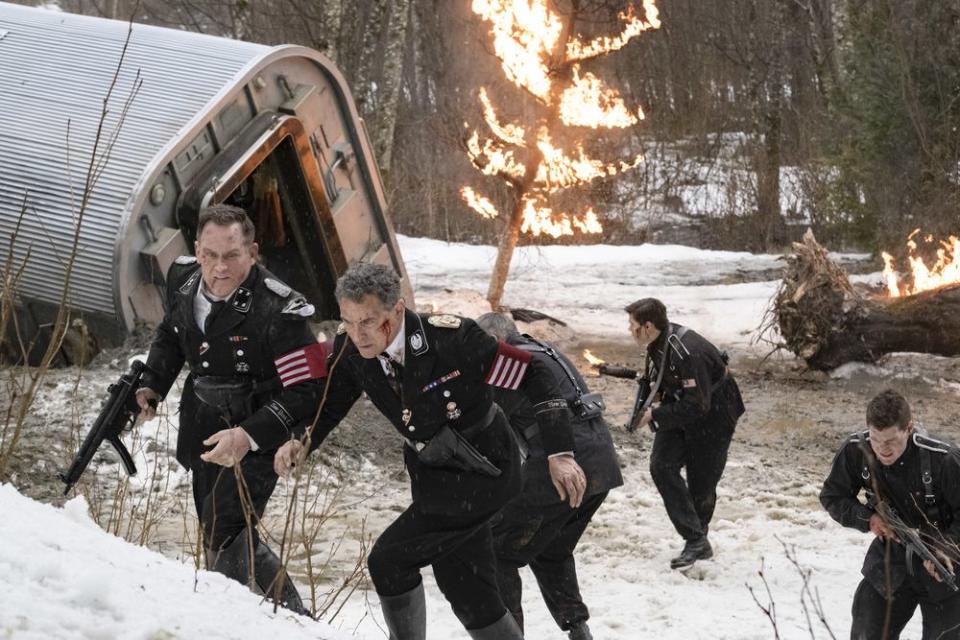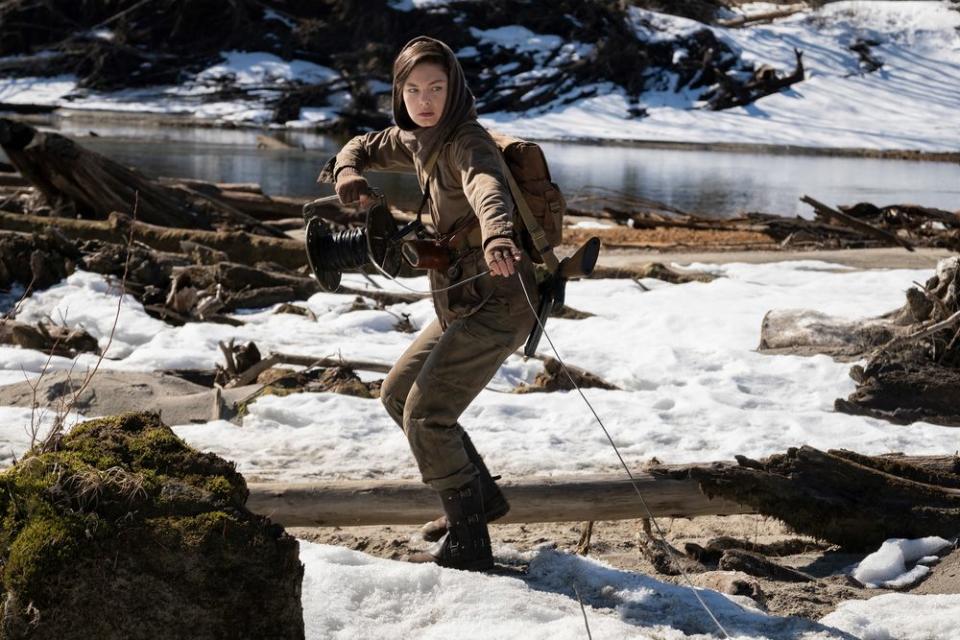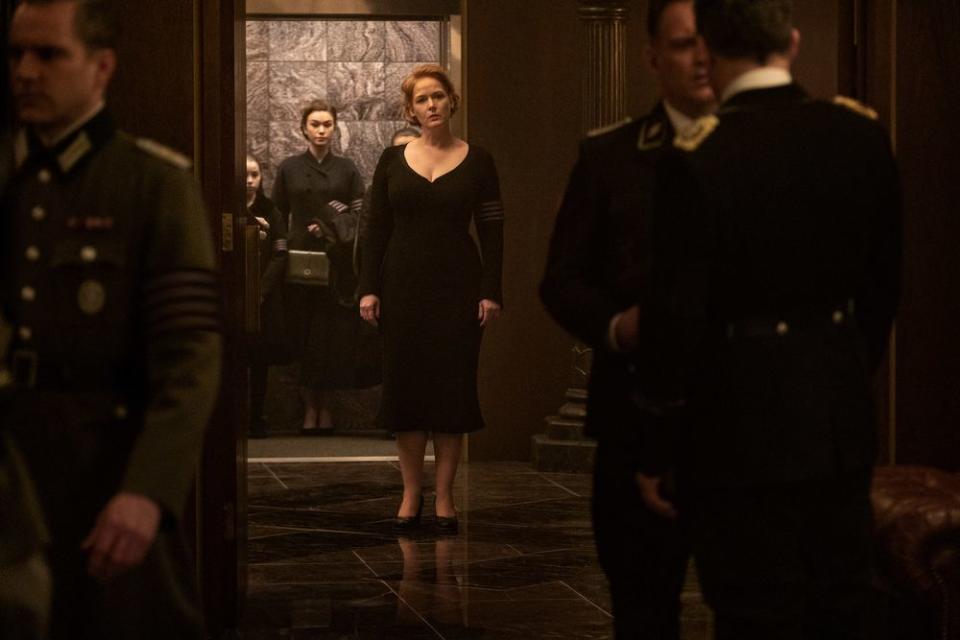The Man in the High Castle ending explained: Series boss unpacks the 'ambiguous' finale

Warning: This article contains spoilers about the series finale of The Man in the High Castle.
In the spirit of Philip K. Dick, the series finale of Amazon’s The Man in the High Castle presented far more questions than answers.
For David Scarpa, who came on as showrunner for this last hoorah, these 10 remaining episodes were about keeping with the “central theme” that runs through the author’s works, “which is that there is no objective reality and, once you realize that, then the only thing that can happen is you lose your mind.” He likens it to Dick’s Do Androids Dream of Electric Sheep?, the basis for Ridley Scott’s Blade Runner movie. “That’s a case where the character’s own identity is in question as to whether he’s human or a replicant.”
With The Man in the High Castle, inspired by Dick’s novel of the same name, a world-changing event occurs in the last episode. With intel provided by Helen (Chelah Horsdal), Juliana Crain (Alexa Davalos) and the Resistance were able to ambush a Nazi train bound for the Poconos after the Japanese decide to end their North American occupation. Newly minted North American Fuhrer John Smith (Rufus Sewell) and his wife are aboard. A rebel explosion hurls the train off its track, killing Helen and compelling John to take his own life in the woods with Juliana, his longtime adversary, by his side to hear his last words.

As she returns to the mines, which the Resistance occupied in the chaos, the portal opens and one of Juliana’s visions comes to pass. Men, women, and children from “everywhere” begin to walk through to her reality. Their faces aren’t clearly visible against the glaring light from the portal, and Scarpa confirms to EW their identities aren’t necessarily crucial for the desired effect of this scene. Are they coming from all parts of the multiverse? Are they alt-world versions of those who died in Juliana’s world?
“There was a considerable amount of discussion between myself and my partner [director and executive producer] Daniel Percival, as well as others, in terms of how much we wanted to be explanatory in that final scene,” Scarpa says. “Part of the intention was to invite the audience to have their own interpretation of what they’re seeing on screen.”
However, he does reveal something. “What should be clear to any viewer is that the portal is, essentially, open and it is going to remain open. In effect, what that means is two worlds have become one. There’s a doorway from one world into the next, and now people can move freely between them. What does that mean? You have ordinary people, in some interpretations, who have been called to this event, who are moving through the portal, and these two worlds are going to be fused.”
While this seems like a hopeful moment for the Resistance, especially for “the Man in the High Castle” himself — Hawthorne (Stephen Root) walks toward the portal to seemingly meet another version of his wife — these final moments for the series aren’t neatly tied up in a bow. “That simply isn’t the way life works,” says Scarpa, who appreciates “ambiguous” finishes like The Sopranos that “invite you to speculate.”

Will the Berlin Reich, which became independent through John’s coup, now retaliate? Will a new leader ascend the ranks of the Reich in America and invade this new world? What will become of the BCR, led by new character Bell Mallory (Frances Turner)? On a much smaller scale, what will become of Helen in the alt-world without her son (in the military) and husband (dead)? What will happen of Kido (Joel de la Fuente), now that he’s an officer for the yakuza in San Francisco?
“This is very much in the Philip K. Dick tradition — every answer only leads to more questions,” Scarpa explains. “For instance, while John Smith is dead and the Reich appears to be overthrown, it’s not at all clear that this America can ever be reunified without conflict. While General Whitcroft, played by Eric Lange, seems to have renounced the Reich, it’s clear that he’s an old American soldier who is determined to return to the Stars and Stripes. Meanwhile, on the West Coast, the Black Communist Rebellion rejects the idea of ever returning to the American flag, or the Republic it represented. So, we may well be setting up for a new conflict, a civil war. This reflects our own questions about the current state of America — whether it can ever be unified, or whether the last three years have left the country forever changed. All we know is that history is never ‘over,’ and that we can never return to the past, either in MITHC world or our own.”
The conclusion also brings an end of an era for Amazon. MITHC, which premiered in November 2015, was the streaming platform’s first big push into the “prestige TV” arena. Isa Dick Hackett, an executive producer on the show since the beginning, says she learned they’d been canceled when she assembled the season 4 writers’ room. Scarpa knew from the jump of his involvement with the show. “In television you get a lot of chances to start something, few shows actually get a chance to finish things,” he mentions. “Typically on TV you just pull the plug and, if you’re lucky, you get to know one episode in advance. It’s a huge opportunity to be able to tell something where you know you’re going to be able to write an ending.”
One idea that helped the writers map out the endgame was “complicity.” In episode 5, titled “Mauvaise Foi” (meaning “bad faith”), flashbacks take us back to how John and Helen earned their place in the Nazi regime at the cost of their Jewish friends’ lives.
In the present, after spending months living in the Neutral Zone, Helen returns to the East Coast to secure a future for her daughters, but the memories of their past acts threaten to unravel both Smiths. “They are two people who lived at a specific turning point in history and, through moral luck, found themselves the most fortunate people in this world, but also the most morally compromised,” Scarpa says. “At what point do they have to face that? In a sense, that was part of the whole season. What is the ultimate fate of these people and the choices they made?”
These questions lead to a conversation between Helen and her own daughter in which she must answer for his past. When the BCR claim a major victory in California and hijack Nazi television, Jennifer (Genea Charpentier) is brought to tears when she realizes her parents built their success on the deaths of minorities through concentration camps. “There are some scenes we saw coming from the beginning and that was definitely one of them,” Scarpa explains. “There’s a lot that has gone unspoken on the show: What happened to African-Americans? What happened to Jews? What happened to LGBTQ people? The other thing that’s really not talked about in this world is what were the Smiths’ complicity in it? We wanted to build up to this final scene so that, finally, all the things that were left unsaid have to be said.”

Another scene Scarpa saw coming was Helen’s confrontation with John. A tip from an undercover Juliana in a department store leads to her discovery of John’s High Castle tapes, the ones that show themselves — including Thomas — in the other world. With Jennifer’s words still ringing in her ears, Helen calls for all of this “to stop” and John replies “I don’t know how.” In an appropriate turn, when this moment occurs, they are both quite literally on a train that won’t stop hurdling forward, until the Resistance forces the entire apparatus to crumble by blowing up the track.
“It’s a series of explosions within this family in which the lies and deceptions and the self-deceptions have been exposed. That’s the final explosion,” Scarpa adds. “That was a scene that we really envisioned right from the start and had to do a considerable amount of planning to build a special train car to design the effects. It was an enormously complicated sequence that Daniel and our effects team all worked on, practically, from the moment we started writing to achieve that. It was about knowing well in advance exactly what we wanted to do and being very, very careful and very specific so that we were able to plan really ambitious sequences and manage that budget in such a way that we were able to order the biggest possible ending to the show.”
As the rebels tore swastikas from the walls in the mines on the show, so too did the MITHC team trash all remains of Nazi paraphernalia made for the series. Their mere presence on the set of the show inevitably took a toll on some of the crew, including production designer Drew Boughton, whom Scarpa mentions “despises those symbols.” As these symbols burn in our world, the showrunner considers their complicated place in the context of MITHC, a show that answered what would happen if the Allies lost World War II? He didn’t want “gratuitous” depictions, but, at the same time, Scarpa didn’t want to “pull punches” or “sugarcoat that world in any way.”
“Each one of these characters has a very specific story that we’re telling but, given where we are in 2019 and the shape of the politics of the country, the world has changed under the feet of the producers since this show premiered,” he says. MITHC first debuted on Amazon at a time when Donald Trump was just announcing his candidacy for president. Then came President Donald Trump, then came Charlottesville, then came immigrant children in cages at detention centers. “The idea of Nazism in America was a purely fanciful one. It was pure alt-history,” Scarpa continues. “Over the course of the next four years, we’ve seen that become a much more uncomfortable, plausible reality.”
It’s hard to foresee how shows will be remembered by our cultural history. At the end of the day, Scarpa says, “We’re all feeling great about where we landed and where we ended up.”
Related content:

